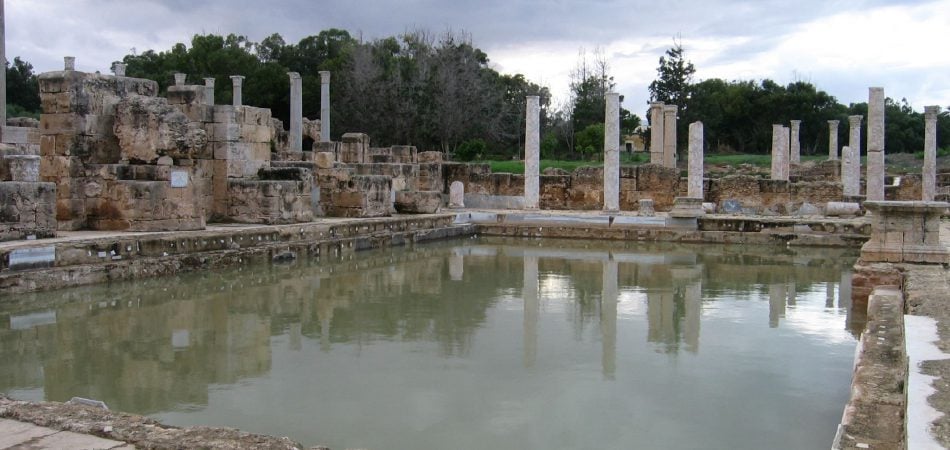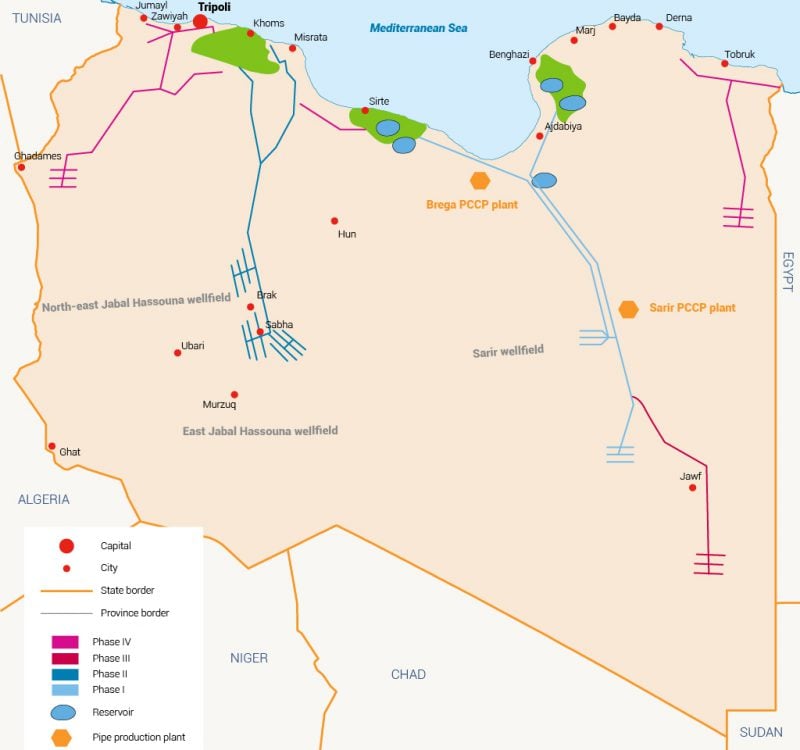
Dams, irrigation systems, wastewater treatment plants, large wellfields
As mentioned in the section on Libya’s water resources, dams were constructed in the north of the country where seasonal surface run-off is common,to control wadi floods, supply irrigation water and recharge underground aquifers.[1] Eighteen dams harvesting rainwater wereconstructed (Table 1) with a total capacity of 389.89 MCM and average annual storage capacity of 61.35 MCM.[2]
Table 1: Dams in Libya.[3]
| No. | Dam name | Design capacity (MCM) | Average annual storage (MCM) |
| 1. | Wadi al-Magineen | 58 | 10 |
| 2. | Wadi Kaam | 111 | 13 |
| 3. | Wadi Ghan | 30 | 11 |
| 4. | Wadi Zaaret | 8.6 | 4.5 |
| 5. | Wadi Libda | 5.2 | 3.4 |
| 6. | Wadi Quattara | 135 | 12 |
| 7. | Supplementary Wadi Quattara | 1.5 | 0.5 |
| 8. | Wadi Mourkos | 0.15 | 0.15 |
| 9. | Wadi ben Gawad | 0.34 | 0.3 |
| 10. | Wadi Zaza | 2 | 0.8 |
| 11. | Wadi Darna | 1.15 | 1 |
| 12. | Wadi Abou Mansour | 22.3 | 2 |
| 13. | Wadi Tabrit | 1.6 | 0.5 |
| 14. | Wadi Al zakar | 1.6 | 0.5 |
| 15. | Wadi Giaaref | 2.4 | 0.3 |
| 16. | Wadi El zahaweya | 2.8 | 0.7 |
| 17. | Wadi El zayd | 2.6 | 0.5 |
| 18 | Wadi Zafer | 3.65 | 0.2 |
| Total | 389.89 | 61.35 |
The irrigation methods practiced in Libya are surface irrigation, sprinkler and drip irrigation and their associated infrastructures. Their direct environmental impact results from emissions, pollution, salinization and alkalinization. Another impact arises from interaction with riparian ecology and regional areas affecting hosting or threatening biodiversity, recycling nutrients and mitigating wadi run-off.[4]
More than 70 WWTPs have been constructed since 1971. Most WWTPs in large cities employ modifications of activated sludge treatment technologies, while a high number of individual residences in unsewered and rurala reasuse septic tank systems. [5]
Freshwater demand has increased since the 1960s, resulting in desalination plants gaining in significance as a solution to supply additional water resources. Many plants were constructed in the coastal cities, using both thermal and membrane techniques.[6]
Concerning large wellfields in Libya, a manmade river project (MMRP) was constructed to fulfil the demand for irrigation and domestic water. Five wellfields were anticipated to produce the following amounts: Sarir 1 MCM/d, Tazerbo1 MCM/d, Hassouna 2.5 MCM/d, Ghadames 250,000 m3/d and Kufra 1.6 MCM/d, utilising 4,071 kilometres of pipeline to transport water (Map 1).
Traditional water collection and distribution systems
Traditional systems are widely used to collect water for irrigation and domestic use. Underground cisterns (fasqiya) collect rainfall in houses inurbane areas, whereas people in rural areas have long depended on canals originating from hand-dug wells, springs and dams. Since the late 1960s, water supply networks have been constructed in most villages, towns and cities across the country.
Planned projects
Planned water projects in Libya aim to meet demand for the agriculture, domestic and industrial sectors. Several WWTPs have been contracted to serve over 400 urban and semi-urban areas, while desalination plants are planned for four large citiesin the north-east and north-west of the country (Tobruk, Benghazi, Sirte and Tripoli).[7] In addition, 20 dams will be constructed to increase total storage capacity byabout136.6 MCM.[8] Regarding MMRPs, two projects out of five, still need to be built: the Ghadames/Zwara system and the Kufra/Tazerbo system.[9]
[1] General Water Authority, 2014 , Water and Energy for Life in Libya (WELL) , Project funded by the European Commission No. 295143, FP7, Libya.
[2] General Water Authority, 2012. Main dams in Libya. General Dams Authority, dams brochure.
[3] Ibid.
[4] Saleh Sadeg and Khalil I. Al-Samarrai, 2018.Raising awareness of good practices Why and How on Sustainable Agriculture in Libya to Reduce Water Stress and Energy Consumption. White Paper published for the5TOI_4EWAS project. EU H2020
[5] CEDARE, 2014.Libya Water Sector M&E Rapid Assessment Report. Monitoring and Evaluation for Water in North Africa (MEWINA) project, Water Resources Management Program, CEDARE.
[6] General Water Authority, 2014 , Water and Energy for Life in Libya (WELL) , Project funded by the European Commission No. 295143, FP7, Libya.
[7] Ibid.
[8] General Water Authority, 2012. Main dams in Libya. General Dams Authority, dams brochure.
[9] General Water Authority, 2014 , Water and Energy for Life in Libya (WELL) , Project funded by the European Commission No. 295143, FP7, Libya.

